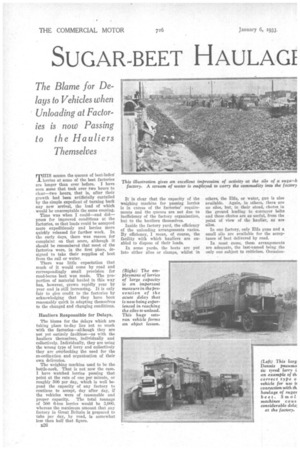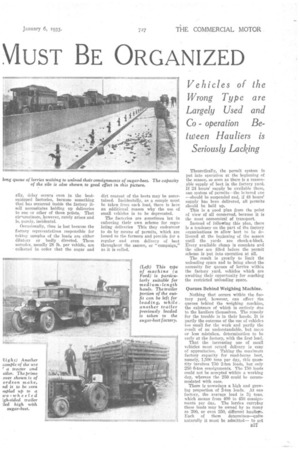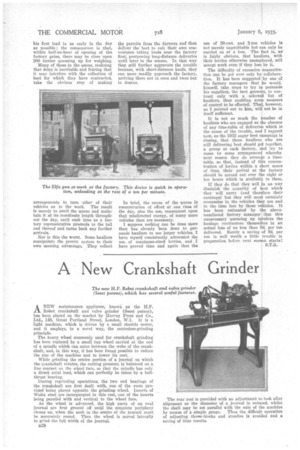SUGAR-BEET HAULAGE MUST BE ORGANIZED
Page 40

Page 41

Page 42

If you've noticed an error in this article please click here to report it so we can fix it.
The Blame for Delays to Vehicles when Unloading at Factories is now Passing to the Hauliers Themselves
rrIHIS season the queues of beet-laden' J.. lorries at some of the beet factories are longer than ever before. I have seen some that took over two hours to clear—two hours, that is, after their growth had been artificially curtailed by the simple expedient of turning back any new arrival, the load of which would be unacceptable the same evening.
Time was when I could—and did— press for improved conditions at the factories, so that loads could be accepted more expeditiously and lorries more quickly released for further work. In the early days, there was reason for complaint on that score, although it should be remembered that most of the factories were, in the first place, designed to take their supplies of beet from the rail or water.
There was little expectation that much of it would come by road and correspondingly small provision for road-borne beet was made. The proportion of material hauled in this way has, however, grown rapidly year by year and is still increasing. It is only fair to give credit to the factories by acknowledging that they have been reasonably quick in adapting themselves to the changed and changing conditions.
Hauliers Responsible for Delays.
The blame for the delays which are taking place to-day lies not so much with the factories—although they are not yet entirely faultless—as with the hauliers themselves, individually and collectively. Individually, they are using the wrong type of lorry and collectively they are overlooking the need for the co-ordination and organisation of their own deliveries.
The weighing machine used to he the bottle-neck. That is not now the case. I have watched lorries passing that point at the rate of one per minute, or roughly 500 per day, which is well beyond the capacity of any factory to continue to accept, day after day, if the vehicles were of reasonable and proper capacity. The total tonnage of 500 6-ton lorries would he 3,000, whereas the maximum amount that any factory in Great Britain is prepared to take per day, by road, is somewhat less than half that figure.
826 It is clear that the capacity of the weighing machine for passing lorries is in excess of the factories' requirements and the queues are not due to inefficiency of the factory organization, but to the hauliers themselves.
Inside the factory yard, the efficiency of the unloading arrangements varies. By efficiency, I mean, of course, the facility with which hauliers are enabled to dispose of their loads.
In some yards, the beets are put into either silos or clamps, whilst in others, the Ella, or water, gun is also available. Again, in others, there are no silos, but, in their stead, chutes in the ground leading to conveyor belts and these chutes are as useful, from the point of view of the haulier, as are
In one factory, only Ella guns and a small silo are available for the acceptance of beet delivered by road.
In most eases, these arrangements are adequate, the last-named being the only one subject to criticism. Occasion
ally, delay occurs even in the bestequipped factories, because something that has occurred inside the factory itself necessitates holding up deliveries to one or other of these paints. That cirr,unistance, however, rarely arises and is, purely, incidental.
Occasionally, time is lost because the factory representatives responsible for taking samples of the loads are either dilatory or badly directed. These samples, usually 28 lb. per vehicle, are collected in. order that the sugar and dirt content of the beets may be ascertained. Incidentally, as a sample must be taken from each load, there is here an additional. reason why the use of small vehicles is to be deprecated.
The factories are sometimes lax in enforcing their own scheme for regulating deliveries This they endeavour to do by means of permits, which are issued to the farmers and provide for a regular and even delivery of beet throughout the season, or "campaign," as it is called. Theoretically, the permit system is put into operation at the beginning of the season, so soon as there is a reasonable supply of beet in the factory yard, If 24 hours' supply be available there, one system of permits—the letered One —should be suspended and, if 48 hours' supply has been delivered, all permits should be held up.
This is a good plan from the point of view of all concerned, because it is the most economical of transport.
Instead of following this plan, there is a tendency on the part of the factory organizations to allow beet to be delivered at the beginning of the season until the yards are chock-a-blodk. Every available clamp is complete and the silos are filled before the permit scheme is put into operation at all.
The result is greatly to limit the unloading space and to bring about the necessity for queues of lorries within the factory yard, vehicles which are awaiting their opportunity for reaching the restricted unloading space.
Queues Behind Weighing Machine.
Nothing that occurs within the factory yard, however, can affect the queues behind the weighing machine, the existence of which is entirely due to the hauliers themselves. The remedy for the trouble is in their hands. It is partly the outcome of the use of vehicles too small for the work and partly the result of an understandable, but more or less mistaken, determination to be early at the factory, with the first load.
That the increasing use of small vehicles must retard delivery is easy ofappreciation. Taking the maximum factory capacity for road-borne beet, namely, 1,500 tons per day, thi-s quantity involves 750 2-ton loads, but only 250 6-ton consignments. The 750 loads could not be accepted within a working day, whereas the 250 could be accommodated with ease.
There is nowadays a high and growing proportion of 2-ton loads. At one factory, the average load is 31 tons, which means from 400 to 450 consignments per day. The lorries carrying these. loads may be owned by as many as 200, or even 250, different hauliers. Each of them determines—quite naturally it must be admitted— to get
his first load iu as early in the day as possible ; the consequence is that, within half-an-hour of opening of the factory gates, there may be close upon 200 lorries queueing up for weighing.
Many of those in the queue, realizing that delay is inevitable and fearing that it may interfere with the collection of beet for which they have contracted, take the obvious step of making arrangements to turn other of their vehicles on to the work. The result is merely to swell the queue and maintain it at its inordinate length throughout the day, until such time as a factory representative proceeds to the tail end thereof and turns back any further arrivals.
Nor is this the worst. Some hauliers manipulate the permit system to their own seeming advantage. They collect the permits from the farmers and then deliver the beet to suit their own convenience taking loads near the factory first, postponing long-distance deliveries until later in the season. In that way they still further aggravate the trouble because, with short-distance hauls, they can more readily approach the factory, arriving there not in ones and twos but in dozens.
In brief, the cause of the queue is concentration of effort at one time of the day, also the use, consequent upon that misdirected energy, of many more vehicles than are necessary.
I suppose nothing can be done more than has already been done to persuede hauliers to use larger vehicles. I have myself consistently advocated the use of maximum-sized lorries, and I have proved time and again that the use of 30-cwt. and 2-ton vehicles is not merely unprofitable but can only be carried on at a loss. The fact is, as is fairly obvious, that hauliers, with their lorries otherwise unemployed, will accept work even if they lose by it.
The difficulty of excessive concentration can be got over only by collaboration. It has been suggested by one of the factory managers that he would, himself, take steps to try to persuade his suppliers, the beet growers, to contract only with a selected list of hauliers, thus enabling some measure of control to be effected. That, however, as I pointed out to him, will not be in itself sufficient.
It is not so much the number of hauliers who are engaged as the absence of any time-table of deliveries which is the cause of the trouble, and I suggest now, as the 1932 sugar beet campaign is closing, that those hauliers who are still delivering beet should get together, a group at each factory, and try to come to some arrangement whereby next season they do arrange a timetable, so that, instead of this concentration of lorries within a short space of time, their arrival at the factory should be spread out over the eight or ten hours which is available to them.
If they do that they will in no way diminish the quantity of beet which they will carry (and therefore their earnings) but they will most certainly economise in the vehicles they use and in the time lost by those vehicles. It has been estimated by the abovementioned factory manager that this unnecessary queueing up involves the haulage contractors themselves in an actual loss of no less than 9d. per ton delivered. Surely a saving of 9d. per ton is well worth a little trouble in preparation before next season starts!
S.T.R.




























































































